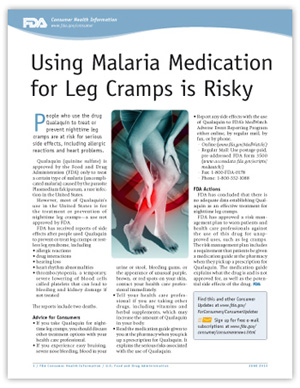Using Malaria Medication for Leg Cramps is Risky
People who use the drug Qualaquin to treat or prevent nighttime leg cramps may be at risk for serious and life-threatening reactions, according to the Food and Drug Administration (FDA).
Qualaquin (quinine sulfate) is FDA-approved only to treat a certain type of malaria (uncomplicated malaria) caused by the parasite Plasmodium falciparum.This infection, which is rare in the United States, is found mainly in travelers who have been to countries where malaria occurs.
However, most of Qualaquin’s use in the U.S. is for the treatment or prevention of nighttime leg cramps—a use not approved by FDA.
FDA has received reports of side effects after people used Qualaquin to prevent or treat leg cramps or restless leg syndrome. Side effects included serious bleeding due to a severe lowering of blood cells called platelets (thrombocytopenia), which resulted in two deaths.
Advice for Consumers
- If you take Qualaquin for nighttime leg cramps, you should discuss other treatment options with your health care professional.
- Contact your health care professional immediately if you experience easy bruising, severe nose bleeding, blood in your urine or stool, bleeding gums, or the appearance of unusual purple, brown, or red spots on your skin.
- Read the medication guide given to you at the pharmacy when you pick up a prescription for Qualaquin.
- Report any side effects with the use of Qualaquin to FDA’s MedWatch Adverse Event Reporting Program either online, by regular mail, by fax, or by phone.
- Online
- Regular Mail: Use postage-paid, pre-addressed FDA form 3500
- Fax: 1-800-FDA-0178
- Phone: 1-800-332-1088
FDA Action
As part of a risk management plan, FDA requires that patients receive a medication guide at the pharmacy when they pick up a prescription for Qualaquin. The medication guide explains what the drug is and is not approved for, as well as its potential side effects.
This article appears on FDA's Consumer Updates page, which features the latest on all FDA-regulated products.
Posted July 8, 2010
Return to FDA Consumer Articles

